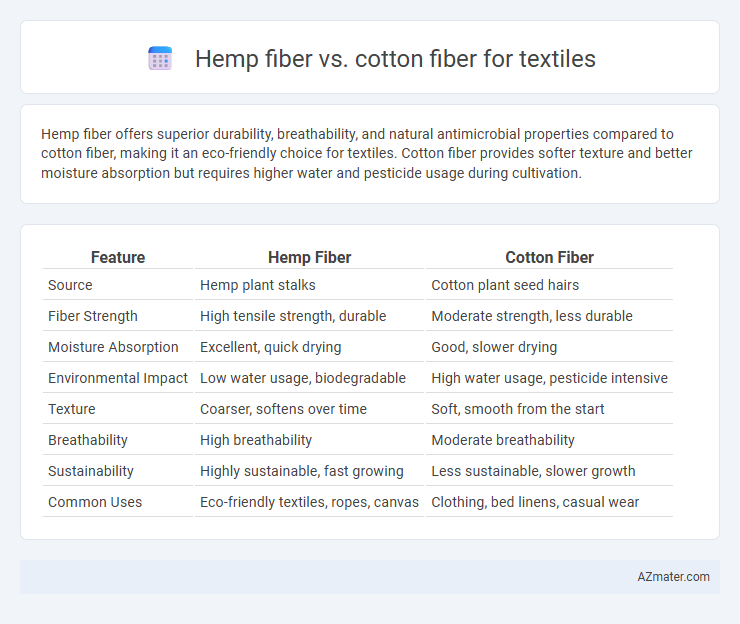Hemp fiber offers superior durability, breathability, and natural antimicrobial properties compared to cotton fiber, making it an eco-friendly choice for textiles. Cotton fiber provides softer texture and better moisture absorption but requires higher water and pesticide usage during cultivation.
Table of Comparison
| Feature | Hemp Fiber | Cotton Fiber |
|---|---|---|
| Source | Hemp plant stalks | Cotton plant seed hairs |
| Fiber Strength | High tensile strength, durable | Moderate strength, less durable |
| Moisture Absorption | Excellent, quick drying | Good, slower drying |
| Environmental Impact | Low water usage, biodegradable | High water usage, pesticide intensive |
| Texture | Coarser, softens over time | Soft, smooth from the start |
| Breathability | High breathability | Moderate breathability |
| Sustainability | Highly sustainable, fast growing | Less sustainable, slower growth |
| Common Uses | Eco-friendly textiles, ropes, canvas | Clothing, bed linens, casual wear |
Introduction to Hemp and Cotton Fibers
Hemp fiber, derived from the stalks of the Cannabis sativa plant, is known for its strength, durability, and eco-friendly cultivation requiring fewer pesticides and water compared to cotton. Cotton fiber, extracted from the seed hairs of the Gossypium plant, is prized for its softness, breathability, and widespread use in textile manufacturing. Both fibers serve distinct purposes in the textile industry, with hemp offering sustainability benefits and cotton excelling in comfort and versatility.
Historical Uses in the Textile Industry
Hemp fiber has been utilized in the textile industry for thousands of years, known for its durability and resistance to pests, with evidence of hemp fabrics dating back to ancient China around 2800 BCE. Cotton fiber, originating from the Indus Valley Civilization around 3000 BCE, revolutionized textiles by offering softness and easier dyeing qualities, leading to widespread use throughout the Roman Empire and eventually global dominance in modern fabric production. Historical records show hemp's use in sails, ropes, and coarse fabrics, while cotton became preferred for garments due to its comfort and versatility.
Cultivation and Environmental Impact
Hemp fiber cultivation requires significantly less water and pesticides than cotton, making it a more sustainable option for textile production. Hemp plants grow rapidly, often reaching maturity in 3-4 months, and improve soil health through phytoremediation. Cotton farming typically consumes vast amounts of water and relies heavily on chemical fertilizers and pesticides, contributing to soil degradation and environmental pollution.
Fiber Structure and Physical Properties
Hemp fiber features a coarse, hollow structure with a high cellulose content, contributing to its superior tensile strength and durability compared to cotton fiber, which is characterized by a finer, more twisted morphology composed mainly of cellulose with a waxy coating. Physically, hemp fibers exhibit greater resistance to UV light, moisture, and microbial degradation, while cotton fibers provide enhanced softness and breathability, influencing their respective applications in textiles for strength versus comfort. The rigidity and shape retention of hemp fibers make them ideal for durable fabrics, whereas cotton fibers excel in lightweight, flexible textiles due to their elasticity and moisture absorbency.
Processing and Manufacturing Differences
Hemp fiber requires less chemical processing than cotton due to its natural resistance to pests and diseases, leading to a more sustainable manufacturing process with lower environmental impact. Cotton fibers undergo intensive treatments including bleaching, dyeing, and the use of pesticides during cultivation, increasing resource consumption and chemical waste. The processing of hemp involves mechanical decortication and retting to separate fibers, whereas cotton fibers are extracted by ginning, highlighting distinct industrial workflows impacting fabric texture and durability.
Durability and Longevity in Fabrics
Hemp fiber exhibits superior durability compared to cotton fiber due to its long, strong bast fibers that resist wear and tear, making hemp fabrics ideal for heavy-duty and long-lasting textiles. Hemp also demonstrates excellent resistance to UV rays, mold, and mildew, contributing to greater longevity in various environmental conditions. Cotton fibers, while softer and more breathable, tend to degrade faster with frequent washing and exposure, leading to shorter fabric lifespan in comparison to hemp-based textiles.
Comfort and Breathability Comparison
Hemp fiber offers superior breathability compared to cotton due to its naturally porous structure, allowing better air circulation and moisture-wicking properties that enhance overall comfort. Cotton fiber is softer and more pliable, providing a smooth texture against the skin, but it tends to retain moisture longer, which can impact breathability and comfort in hot or humid conditions. The durability and antimicrobial qualities of hemp fiber contribute to long-lasting comfort and freshness, making it a preferable choice for breathable textiles.
Dyeing, Finishing, and Aesthetic Qualities
Hemp fiber offers superior dye absorption and retains color vibrancy longer than cotton due to its coarse and porous structure, enhancing fabric durability during dyeing and finishing processes. Cotton fibers provide a softer texture and smoother surface, making them ideal for fine, lightweight textiles with a more consistent and matte aesthetic. The finishing treatments on hemp fabrics often result in a rustic, textured appearance, while cotton allows for versatile finishes ranging from crisp to silky, influencing the final garment's drape and visual appeal.
Cost and Market Availability Analysis
Hemp fiber offers a more sustainable and durable alternative to cotton but generally comes at a higher production cost due to specialized processing requirements. Cotton dominates the textile market with widespread availability and established supply chains, making it more cost-effective for large-scale manufacturing. Market trends indicate a growing demand for hemp fiber in eco-friendly textiles, yet cotton remains prevalent due to lower input costs and extensive agricultural infrastructure.
Sustainability and Future Prospects
Hemp fiber outperforms cotton in sustainability due to its low water usage, minimal pesticide requirements, and rapid growth cycle, making it a renewable resource with a smaller environmental footprint. Cotton cultivation often demands significant water and chemical inputs, which contribute to soil degradation and increased carbon emissions. With growing consumer demand for eco-friendly textiles, hemp's durability and biodegradability position it as a promising alternative for the future of sustainable fashion and industrial textile applications.

Infographic: Hemp fiber vs Cotton fiber for Textile
 azmater.com
azmater.com